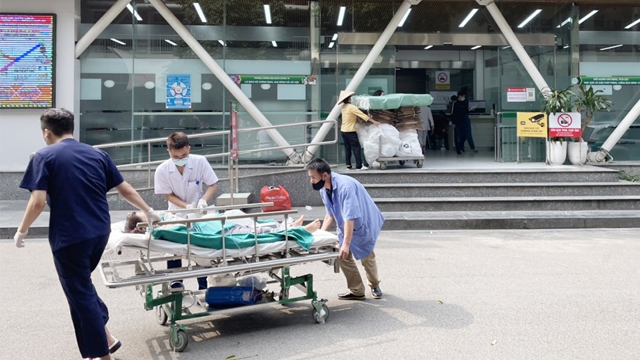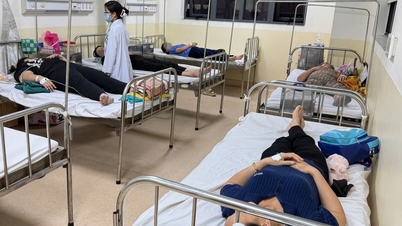On November 27, Viet Duc Hospital informed about the case of a male patient with a rare cerebral venous thrombosis, who underwent emergency intervention to successfully remove the venous sinus thrombosis, re-opening all the large venous sinuses in the brain after ineffective medical treatment.
This is a rare and severe condition, with a risk of brain damage and neurological sequelae if not treated promptly.
Previously, a male patient named NAT in Phu Tho was admitted to the hospital with a severe headache that lasted for a week, accompanied by double vision. At a lower-level hospital, T. was diagnosed with cerebral venous thrombosis and treated with standard-dose anticoagulants, but there was no improvement, and the symptoms even worsened, forcing the patient to be transferred to a higher-level hospital.
X-ray results at Viet Duc Hospital showed that the patient had almost the entire cerebral venous drainage system blocked, including the superior sagittal sinus, transverse sinus, sigmoid sinus and the first part of the right internal jugular sinus.

X-ray images clearly show the severity of the patient's blockage (Photo: Provided by the hospital).
Doctor Dao Xuan Hai - Department of Diagnostic Imaging, Viet Duc Hospital said that most patients with cerebral venous thrombosis respond well to medical treatment, but in this case the blood clot was very large, completely blocking the large venous sinuses and worsening despite taking medication.
Due to the high risk of circulatory stasis, leading to brain tissue damage and severe sequelae, the doctors held an interdisciplinary consultation and decided to perform thrombectomy intervention while continuing to maintain anticoagulant medication.
Unlike arterial thrombosis, to remove cerebral venous thrombosis, the doctor must access the vein.

Doctor Le Quoc Viet, Department of Internal Medicine - Neurological Intensive Care, examines a patient after surgery (Photo: Provided by the hospital).
After determining the location of the blood clot on the DSA machine, the doctors used a system of instruments inserted from the femoral vein to the right internal jugular vein to remove the blood clot from the internal jugular vein up to the superior sagittal sinus - the location of the blood clot. From here, the doctor removed the entire blood clot from the superior sagittal sinus down to the internal jugular vein to recanalize the cerebral venous sinus system.
Immediately after the intervention lasting more than 2 hours, the flow in the venous sinus system was significantly improved, the patient's headache symptoms quickly reduced and the risk of cerebral hemorrhage was avoided.
The combination of thrombectomy and medical treatment effectively restored venous flow while preventing the risk of new thrombosis formation.
According to Dr. Hai, this technique is not routinely indicated because of its high complexity and is only applied in special cases: occlusion of many large veins; no response to medical treatment; severe progression of symptoms.
After 5 days of intervention, the patient's headache symptoms were completely gone, his physical condition was stable and he responded well to treatment. Paraclinical indicators were significantly improved, the patient was alert, communicated well and had almost normal activities.
Currently, the patient continues to be monitored and rehabilitated to prevent the risk of recurrence.
Source: https://dantri.com.vn/suc-khoe/nam-sinh-19-tuoi-dau-dau-du-doi-1-tuan-phat-hien-huyet-khoi-hiem-gap-20251127083236147.htm



![[Photo] Prime Minister Pham Minh Chinh chairs the 15th meeting of the Central Emulation and Reward Council](/_next/image?url=https%3A%2F%2Fvphoto.vietnam.vn%2Fthumb%2F1200x675%2Fvietnam%2Fresource%2FIMAGE%2F2025%2F11%2F27%2F1764245150205_dsc-1922-jpg.webp&w=3840&q=75)
![[Photo] President Luong Cuong attends the 50th Anniversary of Laos National Day](/_next/image?url=https%3A%2F%2Fvphoto.vietnam.vn%2Fthumb%2F1200x675%2Fvietnam%2Fresource%2FIMAGE%2F2025%2F11%2F27%2F1764225638930_ndo_br_1-jpg.webp&w=3840&q=75)































































































Comment (0)